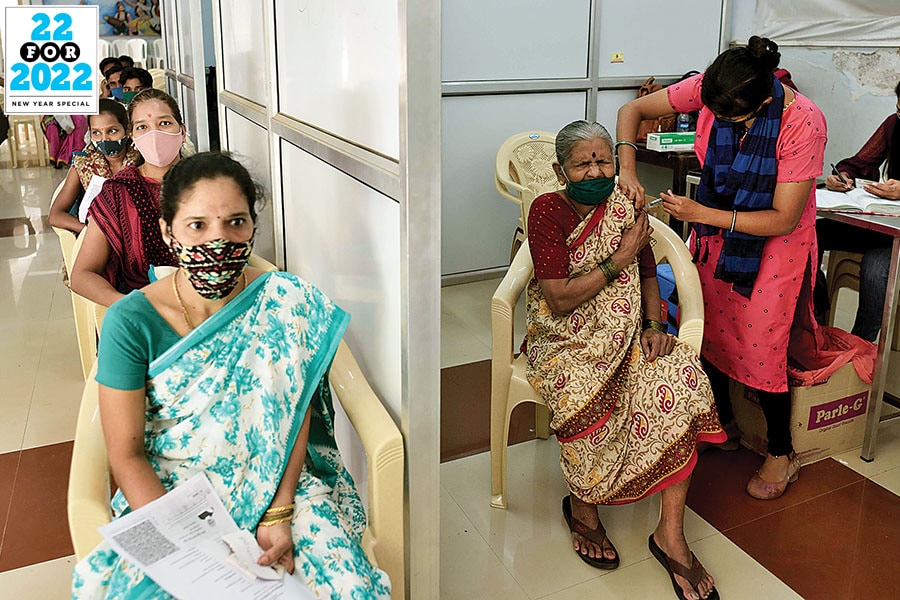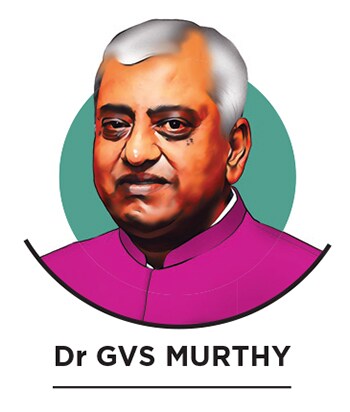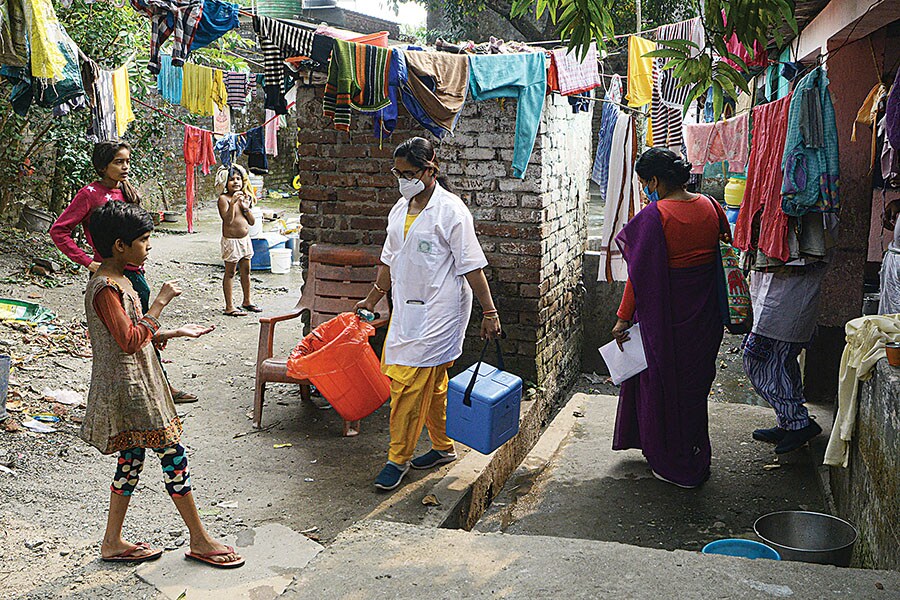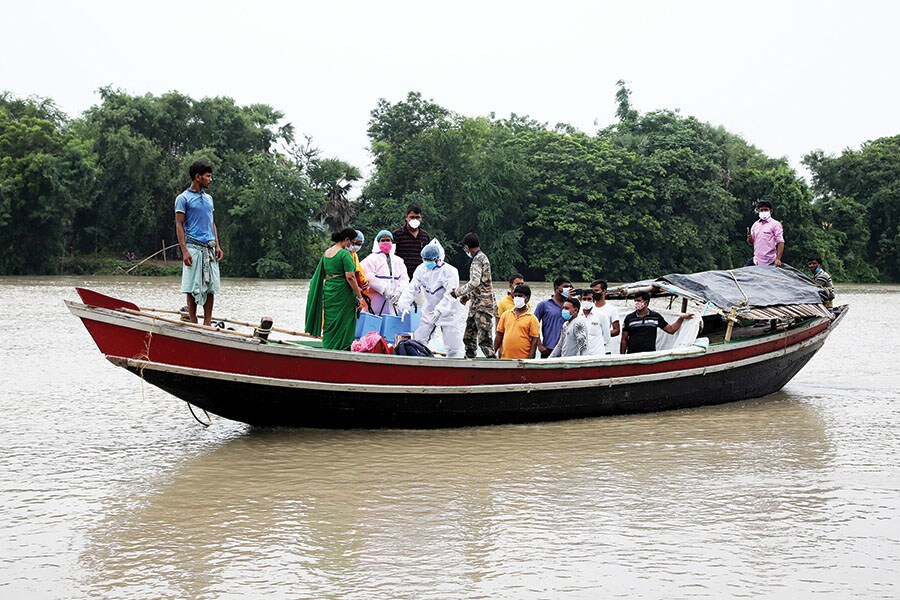
Omicron: India's vaccination plan needs a boost - Dr GVS Murthy
By Dr GVS Murthy| Jan 12, 2022
As new variants of Covid-19 emerge, the government must have a clear booster policy that will encourage more global manufacturers to ship vaccines to India, the director of Indian Institute of Public Health-Hyderabad, writes
 India needs 200 million doses per month over the next six months for primary immunisation, and 100 million doses per month of boosters for high-risk groups
India needs 200 million doses per month over the next six months for primary immunisation, and 100 million doses per month of boosters for high-risk groups
Image: Satish Bate/ Hindustan Times/ Gety Images
 India initiated Covid-19 vaccination in January 2021 and initially there were hiccups impacting uptake. This was both due to systemic factors like vaccine shortage and behavioural factors like vaccine hesitancy. The sudden surge of infections from March jolted people out of their slumber and long queues were seen at vaccine centres. However, shortages and few distribution outlets affected delivery. By September, there was a marked improvement in supplies and distribution, and bureaucratic hurdles were removed to augment vaccine coverage.
India initiated Covid-19 vaccination in January 2021 and initially there were hiccups impacting uptake. This was both due to systemic factors like vaccine shortage and behavioural factors like vaccine hesitancy. The sudden surge of infections from March jolted people out of their slumber and long queues were seen at vaccine centres. However, shortages and few distribution outlets affected delivery. By September, there was a marked improvement in supplies and distribution, and bureaucratic hurdles were removed to augment vaccine coverage.
In early May, only 29.1 million people (2.1 percent of the total population) were vaccinated. By August 31, only 36 percent had received at least one dose and 10.7 percent were fully vaccinated, meaning there had been a significant scaling up in the last three months. In the April-June period, vaccine coverage reduced as there was a shortage. As of December 8, 802,894,059 people (58.2 percent) have received at least one dose. However, only 34.8 percent were fully vaccinated.
_RSS_Compared to many high income countries, vaccine hesitancy has been lower in India. With a vaccine acceptance of around 75 percent, India has done well in allaying people’s fears and apprehensions. Vaccine production has been ramped up significantly and the country now has the capacity to deliver three billion doses annually.
Vaccines have revolutionised the fight against Covid the world over. Though the outcome measure during the validation phase for all vaccines was the potential to reduce death and hospitalisation, in actual effect, vaccines have also been effective in reducing infection among those fully vaccinated. Studies from India have shown that vaccine effectiveness in preventing infections was 52 percent after a single dose and 83 percent after two doses among those aged 45 or older. This dose-dependent protection, which starts around two weeks after the first dose, against infection, hospitalisation and admission to ICUs and reduced mortality has been the game-changer.
Though the state governments are responsible for vaccine delivery, the protocols and policies are articulated by the Centre. To provide a seamless vaccine delivery service, coordination between the two governments could have been better. To have the manufacturers on board right at the beginning, the central government should have provided financial support upfront for an assured uptake of vaccine. This could have avoided the vaccine shortages witnessed across many states. The system of prior registration using an app and technical glitches made the app either inaccessible to the poor or illiterate or was difficult to access. Trust levels suffered because people who registered online had to wait for long to get a shot or were turned away due to poor supply. Limited vaccination centres was another hurdle. Recording of data of people vaccinated was also poorly documented in the initial stages in some states and people got vaccination certificates with faulty data or those vaccinated were shown as un-vaccinated.
States should have been provided special budgets to procure vaccines from both domestic and international manufacturers from funds collected under PM-Cares so they could pay the manufacturers upfront for supplies.
To achieve universal vaccination coverage, vaccination should be equitable. The government should provide free vaccine only to those who cannot afford it.
Beneficiaries covered under the Ayushman Bharat insurance scheme or the various state health insurance schemes or employee insurance schemes along with children of public-funded or public-aided schools, the elderly and people with disability etc should be provided free vaccine. All those who can afford the vaccine should pay. To cover this cost, part of the GST collections and the PM-Cares Fund should be used, and not the regular health budget. If the regular health budget, which is already low, is used to buy and provide vaccines, it will catastrophically impact preventive services and primary health care services.
India needs 200 million doses per month over the next six months for primary immunisation and 100 million doses per month of boosters for high-risk groups. Therefore, there may be a need to import approved vaccines, at least to cover the booster doses. Worrying is the fact that the Serum Institute of India has planned to reduce 50 percent production of Covishield, as the government has not placed firm orders for the future.
Temporary waiver of intellectual property rights in vaccine manufacture should be waived for one year so that local production in densely-populated countries like India may boost manufacturing. 
Strategies to vaccinate children will need to be rolled out quickly so that education does not suffer
Image: Diptendu Dutta / AFP
Quicken pace of vaccination
Since more than 80 percent of health services in India are provided by the private sector, privatising vaccine roll-out can accelerate the pace of vaccination. Walk-in vaccination should be provided with no shortages to improve the pace of coverage. Devolution of vaccine centres to smaller sites or smaller population aggregations will speed up vaccine administration and be safer too.
With variants like Omicron affecting those who have been infected earlier and those fully vaccinated too, it will be better to avoid overcrowding at vaccination sites by planning to administer at the household level or a common location near the house. Village panchayats, mahila mandals, SHGs (self-help groups) and urban ward formal and non-formal leaders should be roped in to convince people and to participate at the vaccination sites in their localities.
Reports show that in South Africa, a significant proportion of the population—though infected earlier and antibody positive—still got infected with the Omicron variant leading to rapid spread. India should learn from this and not talk about herd immunity being a protective barrier, but redouble efforts to improve communication regarding new variants.
One modality to speed up Covid vaccination is by clubbing it with childhood immunisation. On the day childhood immunisation is scheduled at a location, all adults needing a Covid shot, especially mothers accompanying the children, should be offered the vaccine. This optimises the human resources as both vaccines can be administered at the same sitting. At the moment, health workers are busy with Covid vaccine delivery and this is affecting the delivery of other preventive health services.
Booster doses
Many more vaccines than are currently available will be available for distribution by 2022. The Prime Minister has announced the roll out of an additional ‘protective’ dose to the elderly, frontline personnel and those with co-morbidities. This is a timely step as the next major surge is expected in February-March 2022. This additional dose is in effect a booster shot and should yield positive benefits as has been seen in countries like Israel.Evidence shows that for those infected with Covid earlier, antibodies are at high levels in the initial three months and then wane off. A similar dissipation of antibody levels is also seen after vaccination, though the levels are more prolonged than after a natural infection. The waning off is seen more sharply with some vaccines compared to others. Therefore, a booster dose is justified in the face of the pandemic. However, this has to be titrated against what proportion of the population has been covered by primary vaccination, the priority. If this reaches 70-75 percent, then boosters should be offered, especially to frontline workers and those at risk.
Once this decision is taken, more international manufacturers may be willing to ship vaccines to India. There is growing evidence that a vaccine cocktail, where primary vaccination is with one type of vaccine and the booster is with a different type, boosts the immune response. This is only possible when different types of vaccines are available in the country.
Strategies to vaccinate children will need to be rolled out quickly so that education does not suffer. Such campaigns can be offered on the school premises, so that children and staff need not visit health centres. Many countries have already initiated vaccination for kids.
A lot of work is going on for single-dose and non-injectable vaccines, like a nasal vaccine. If these products are found to be successful and safe, they will improve vaccine uptake dramatically. Single dose vials with pre-filled syringes would need to be developed soon so that vaccines can be administered at home like a flu shot and people do not need to congregate in large numbers to receive a dose. This will also boost participation of the private and NGO sector in vaccine delivery.
 With variants like Omicron reinfecting and affecting the fully vaccinated, overcrowding at vaccination sites can be avoided by administering vaccines at the household level
With variants like Omicron reinfecting and affecting the fully vaccinated, overcrowding at vaccination sites can be avoided by administering vaccines at the household levelImage: Rupak De Chowdhuri/ Reuters
Tackling challenges
A clear-cut policy on vaccine roll-out, including boosters, needs to be quickly articulated so that the producers can plan accordingly. The current vaccines are entirely based on the original Sars-CoV-2 strain and one does not know how protective they are against new variants like Omicron. Kick-starting efforts for production of updated vaccines to tackle the variants is urgently required.Omicron is rapidly outcompeting the prevalent Delta variant which had replaced the Beta variant. It is presumed that Omicron would be responsible for more than half the cases in Europe in the next few months. This is worrisome as the number of new daily cases in South Africa is doubling at a much faster rate than in any of the earlier three waves in the country and that younger people feature prominently among new cases now with a sharp increase in admission of under-fives in hospitals.
There would be new variants in the next few years too and we have to be prepared. It is likely that towards the later part of 2022, Covid-19 may establish itself as an endemic disease in India (present continuously at low intensity), but mutations will keep occurring like with influenza, where the vulnerable populations have to be vaccinated every year with an updated vaccine.
Generally, emerging variants not only result in increased transmissibility, morbidity and mortality but also have the ability to evade detection by existing or currently available diagnostic tests which can potentially delay the diagnosis and treatment and exhibit decreased susceptibility to treatment.
When reinfections and breakthrough infections are reported in large numbers with new variants, the attainment of herd immunity is not possible as newer vaccines have to be developed. So even if ‘herd immunity’ is achieved at one point in time, it is transient or temporary and may not protect against newer strains.
Strengthening public health
A dedicated workforce skilled in public health is needed at all levels of health care. Bits-and-pieces professionals pushed to manage a public health emergency are bound to fail during crises because the learning curve is steep and one needs to learn on the job. Such professionals need to be nurtured carefully over time. A multi-disciplinary public health workforce is critical for success. A communication expert helps in identifying how information should be conveyed, a behavioural scientist knows how to get communities engaged, an epidemiologist discerns disease trends, a laboratory specialist helps in early detection, a modeller predicts how things may change while public health professionals involved in direct patient care provide evidence-based health interventions. Decisions that will impact the health status of populations have to be taken by public health experts and authority for this has to be vested in them through policy directives.The writer is the director of the Indian Institute of Public Health-Hyderabad